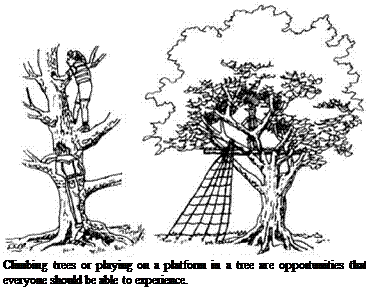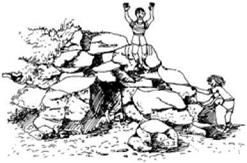Compared with most urban environments the outdoors already has many key ingredients in a natural or semi-natural state. These ingredients present no dangers to children if used correctly and managed properly, while at the same time avoiding the reduction of excitement found in urban play areas. A balance must be struck between the need for children to express themselves and unacceptable risks of injury.
– Space is usually greater, so that exploring the area takes much longer. Games can take up more space, and it will be easier to find somewhere quiet. There is plenty of room for places for small children to be separated from those for older ones.
– Landform can be a great asset. High points, steep slopes, valleys, dark hollows, ledges and natural amphitheatres all provide excellent starting points for role-playing games, as places to explore and conquer and locate challenging equipment. Swings are always more exciting where they fly out over a hollow. Ropeways can run across valleys or down slopes. High points make ‘castles’, or give views to the wider world. Rolling down slopes, climbing steep banks and hiding in hollows or small caves are further ideas.
– Water is a magnet to everyone, especially children.
Running water can be dammed or channelled, squirted, splashed, bridged, fished and used in many other ways. Ponds or shallow lakes can be paddled in, sailed on, made to splash when stones are thrown in, fished in and so on. They may also present dangers unless children are well supervised. Pumps, taps, grooved and hollow logs, stones and planks all help the imaginative use of running water.
– Rocks and stones can be used in situ if they are too big to move for climbing, although they must not be too high or rough. They can supply hiding holes, shelter, imaginary defences, castles or dens. Smaller stones can be moved to build with, to dam a stream, to make stepping stones, or to be used as seats. Gravel and sand can be dug, shovelled, drawn in, made into hills and used for all sorts of games.
– Grassy swards permit all manner of impromptu or organized ball games, as well as running around, lying on and rolling down a hill or slope. Ball games in natural open areas can be more stimulating than on an urban playing field, especially when a ball shoots off into nearby undergrowth!
– Trees and shrubs also give plenty of opportunities for play. Climbing trees is a rare pleasure to most urban children, and is usually far less dangerous in a forest with soft earth and dead leaves beneath it. Broad-leaved trees with spreading branches are safer than conifers. Getting used to heights, developing climbing skills and seeing the world from a new perspective are all values associated with tree climbing. Swings may be attached to sturdy branches and tree houses constructed, which children can relate to fairy tales, folk legends or other stories.
– Shrubs are often as tall as or taller than children, and so they give a greater sense of enclosure. Adults are tall enough to be able to look into areas where children are exploring and so oversee them. Shrubby areas are also ideal for making ‘dens’, and they provide other materials such as twigs, leaves or edible fruit. In the right circumstances dead wood can be used to light a fire and experiment with camp cooking (see Chapter 7).
– Vegetation can also be used to separate the overall area into different spaces for different uses. It can give shelter, shade, a physical barrier, for example against dogs, and show seasonal changes to help children become aware of the cycles of the natural world.
– The outdoors offers a chance to observe wildlife at relatively close quarters. Shy mammals will mostly move away while birds, butterflies, beetles, frogs and toads may all be more easily seen. Chapter 11 expands on ways to incorporate wildlife watching into outdoor recreation.
 |
This sketch shows how the possibilities of a piece of land offer themselves for various kinds of play. Even the most ordinary places have something to offer.
|
|
Rocks used for climbing, jumping or hiding— either natural or specially put into place.
 |
Provision for play
Although most urban play areas are equipped with elaborate and colourful structures, it does not follow that these need be used in the outdoors; indeed many may offer only a low play value. We should instead start by making the most of what the site has to offer, and add artificial components selectively to enhance and dramatize rather than to substitute for natural objects. In this way the unique quality of play in the outdoors can be highlighted.
The selection of the area in which to develop play is an important decision. Finding a place that is near to the picnic area and car park and yet has many of the resources listed in the previous section would be ideal. Some areas will be well endowed with landform. Others are going to be good for water, while some may have few features unless these are introduced. Mounds can be created in flatter areas; quickgrowing shrubs can be used to provide enclosure and mystery if the site is too open. Natural materials such as rock, sand, logs and branches can be brought onto the site.
Site design will be needed to develop some of the features, and to divide the area into zones suitable for different age groups. Such zones can be signalled with certain key
structures to show the size of child expected, by placing more seats for parents near areas for small children and also by signs.
More compact sites may have sections with closely spaced play structures, while larger ones can be more dispersed. A play trail can be developed, where paths lead from one area to another through woodland or amongst shrubby areas. This can heighten the sense of exploration and discovery, and also challenge some of those fears described above, yet reduce the risk of actually getting lost by providing markers or a path.
A few structures of a more dramatic sort can enliven most sites, but opportunities to explore and develop the social and cognitive aspects of play are important. Collecting and using materials found on the site to construct features is usually more interesting and creative than using those that are provided. A ‘den’ or hut built from branches and other vegetation can provide far higher play value than a readymade hut, however artistic or cunning it might be.




